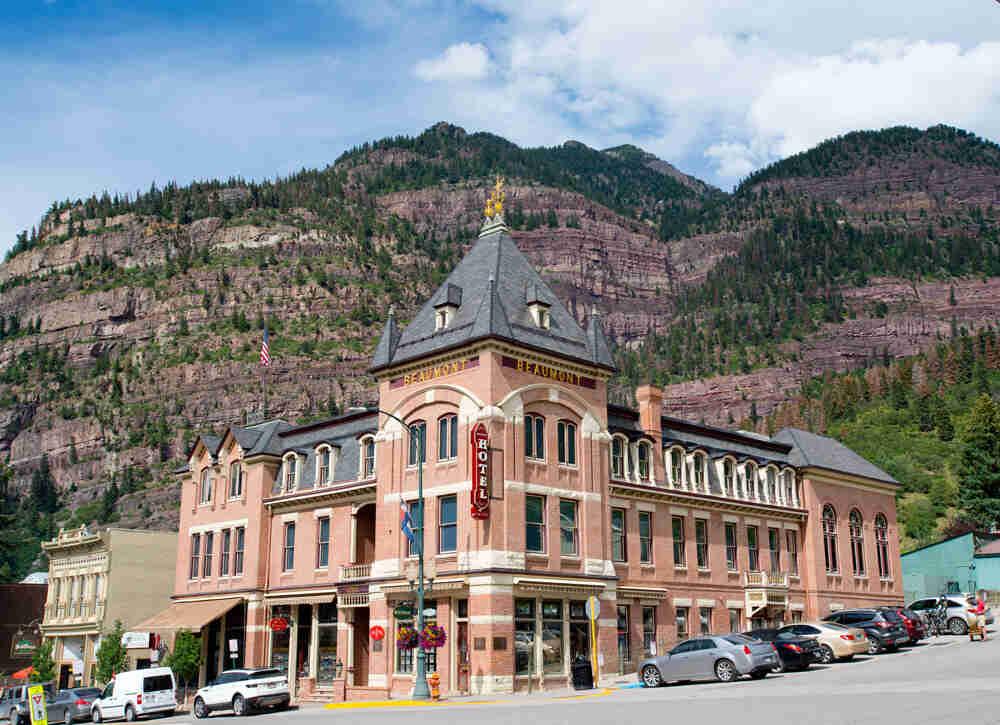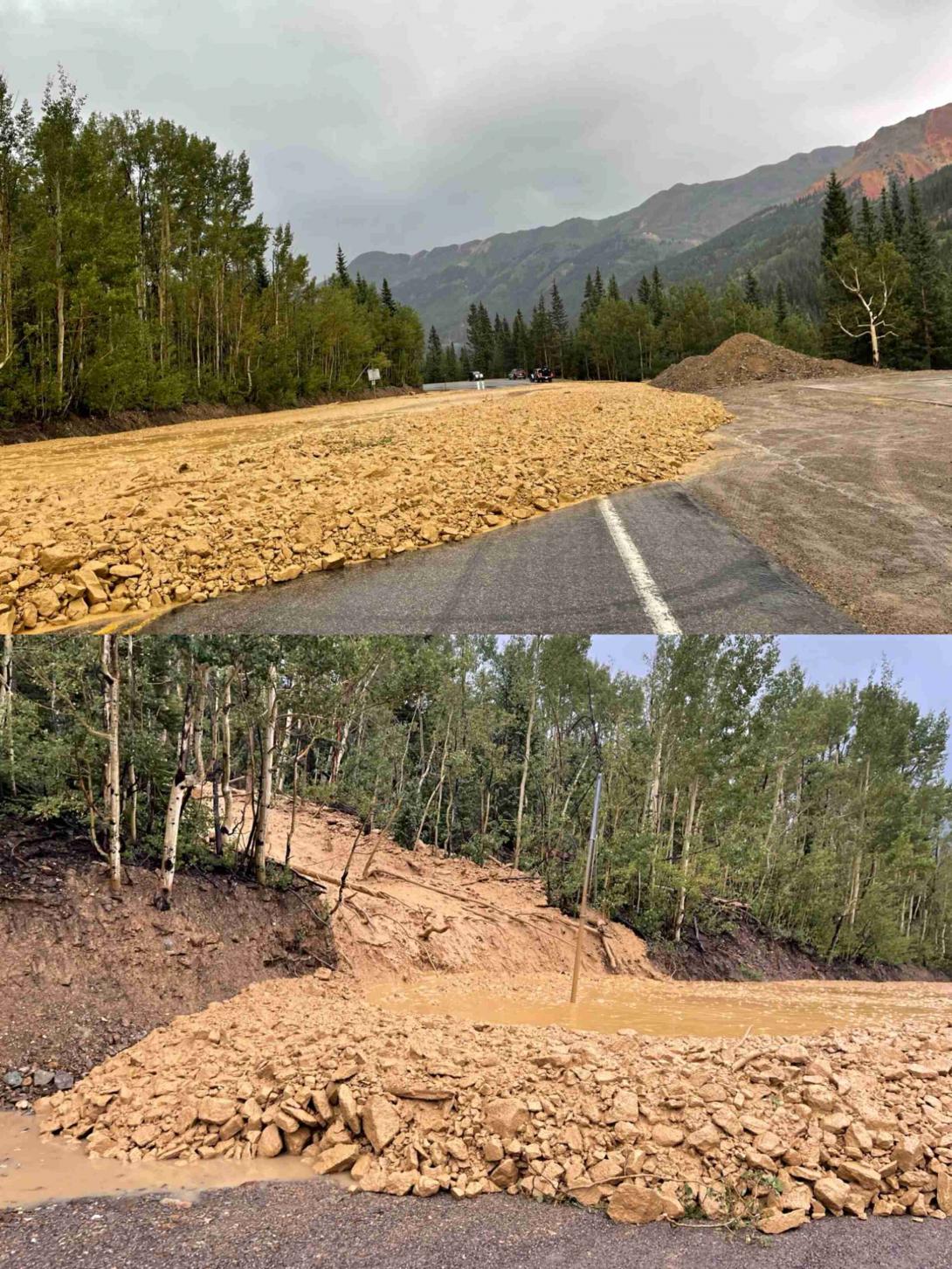Ouray (town)
Full Article
The town of Ouray was founded in 1875 along the Uncompahgre River near where it runs north out of the San Juan Mountains. Two years after the Nuche (Ute) people were dispossessed by the Brunot Agreement in 1873, prospectors found silver and later gold in the area and platted Ouray in a natural amphitheater surrounded by awesome, 5,000-foot walls of red, grey, and beige. The town’s name commemorates the Ute leader who signed the agreement. Ouray’s peak census count of 2,789 came in 1890. After the silver crash of 1893, Ouray’s population declined to a low of 707 residents in 1930 before slowly climbing to 1,010 by 2022. The seat of Ouray County, this picturesque town now relies on tourism, summer residents, and a growing number of retirees.
Early Years
By the time Ouray was incorporated in 1876, it had already boasted a population of 400. It had 214 buildings, including four general stores, two blacksmith shops, a sawmill, an ore sampling works, saloons galore, two hot bathhouses, two hotels, a post office, and a schoolhouse with forty-three students. Saloon names suggest Ouray’s major ethnic groups: The Roma, Pat’s Place, The Bon Ton, and Swedish taverns lined the blocks. In 1877 it was named the seat of Ouray County. It boasted waterworks, telegraph service, and a vigilant volunteer fire department that (along with the town’s brick and stone buildings) made Ouray one of the few mining towns never to suffer a major fire.
Before the Denver & Rio Grande Railroad arrived in 1887 from Montrose, the remote town reached the outside world via the Barlow and Sanderson Stage and Otto Mears’s toll roads: the Lake Fork and Ouray (1877), which connected east to Saguache, and the Ouray and San Juan (1881), which ran south to Red Mountain and Silverton. The latter road evolved into US Highway 550, the famous “Million Dollar Highway” that is now one of the state’s most scenic drives. Travelers could also negotiate with Ouray’s livery stables for mules or horses.
Riches of the Earth
A mining supply town, Ouray served many rich mines within its orbit—the Red Mountain, Imogene, and Sneffels districts. Red Mountain’s Yankee Girl head frame is probably the most photographed mine in Colorado. Other Red Mountain jackpots were the Grand Prize, Guston, National Belle, Orphan Boy, and Treasure Trove. To tap into rich Red Mountain ores, Otto Mears built the Silverton Narrow Gauge Railroad in 1888. This unique rail system had a reputation as the steepest (5 percent grade) and most crooked (30-degree curves), but also the most profitable railroad in Colorado.
Silver mining initially attracted prospectors, and Ouray boomed as prices climbed as high as $1.21 an ounce. When the federal government stopped subsidizing silver by repealing the Sherman Silver Purchase Act in 1893, the price crashed to 50 cents an ounce and silver mining collapsed. Ouray’s decline was eased by the presence of gold along with a little zinc, lead, and copper in the American Nettle, Camp Bird, Revenue, Virginius, and other treasure troves. These major gold mines lay in the Mount Sneffels District eight miles south and 4,800 feet higher than Ouray. It was lucrative but dangerously hard to reach because of rockslides, deep snow, and deadly avalanches.
Thomas F. Walsh, an Irish immigrant, made his Camp Bird Mine the best-known and most prosperous gold mine in the county. After opening in 1896, the Camp Bird yielded millions before Walsh sold it to a British firm for $6 million. Walsh’s wealth bought for his daughter Evalyn the Hope Diamond and for the town of Ouray a library and the town hall’s clock and bell tower. His Camp Bird and the Idarado, the biggest producer in the county during the 1970s, were both worked until the 1980s.
Unlike most San Juan Mountain towns, Ouray’s relatively low elevation (7,706 feet) allowed some agricultural activity, with hay, oats, wheat, and barley flourishing in the well-watered, broad Uncompahgre River valley north of town. The lush valley also supported cattle and sheep.
Switzerland of America
David Frakes Day, the founding editor of Ouray’s newspaper, The Solid Muldoon, maintained as early as the 1880s that tourism, as well as gold and silver, was a resource to be mined. He was right: Tourism thrived after 1887, which saw the opening of one of Colorado’s grandest hotels, the three-story Beaumont, and the arrival of the Denver & Rio Grande Railroad. Ouray began billing itself as “The Switzerland of America” thanks to its snowcapped Alpine scenery. The major attraction in town was the large municipal hot springs, pool, and bathhouse, which opened in 1926. Natural hot springs in and around Ouray had long been used for smaller pools, geothermal heat, bathing, and commercial bath houses. To lure tourists, promoters puffed the waters’ supposed medicinal powers in newspaper ads: “Radium Vapor Health Institute. Hot Vapor Cave Baths. Natural Massages. Rubs. Electric Treatments.” Other natural wonders near Ouray included Cascade Falls, Bear Creek Falls, and the Box Canyon.
Today
Tourism and outdoor recreation continue to drive the local economy. Jeep tours of the surrounding mountains have become a major local business. These excursions take rubber-neckers to Yankee Boy Basin, with its awesome carpet of wildflowers, to various ghost towns, and to the ruins of many a mine. Numerous hiking and motor trails start in town, including paths to the Box Canyon and lower and upper Cascade Falls. Rock climbing has also emerged as a major attraction. During the 1990s, Ouray also began aggressively promoting winter tourism by keeping the natural hot pool open all year, encouraging cross-country skiing, and marketing itself as the American ice-climbing capital, with an annual ice festival held in January at the Ouray Ice Park.
From the beginning, Ouray strove for architectural prominence and permanence by building in brick and stone. In 1983 the town was designated as a National Register Historic District encompassing 331 structures. Its unusually intact, well-preserved Main Street features the elegant Beaumont Hotel, the chateau-like Elks Club, the Wright Opera House, and many handsome storefronts. Quiet, tree-shaded streets are lined by well-kept Victorian homes in one of Colorado’s best-preserved mining towns.
The Ouray County Historical Society has fought to save the town’s historic structures, including the famed Yankee Girl Mine head frame. The Society has also negotiated with the Environmental Protection Agency to keep environmental cleanup from wiping out ghost towns and mine sites. The agency has worked since the 1980s to remove and stabilize toxic tailings and reduce the effects of acid-mine drainage on local waterways.





























